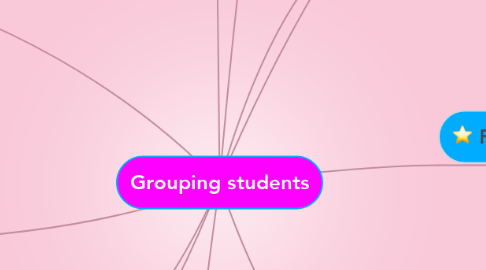
1. Troubleshooting
1.1. Monitor
1.2. Keeping our eyes open for problems
1.3. Finishing first
1.3.1. Task-related
1.4. Awkward groups
1.4.1. Observe
1.4.2. Reorganise the groups in other ways
2. Ringing the changes
2.1. SS change to think about an issue
2.2. Quickly-organised pairs
2.3. Oral interaction
2.4. Involved whole-class grouping
3. Organising Pairwork and groupwork
3.1. Pairwork and groupwork are worth doing.
4. Making it work
4.1. Campare answers
4.2. Discuss pairwork or groupwork
4.3. Compare ideas
5. Creating pairs and groups
5.1. Friendship
5.1.1. T. should work to make all SS accepting of each other.
5.1.2. Piece of paper in order of preference
5.1.3. Like and doesn´t like
5.2. Streaming
5.2.1. Ability or level of participation
5.2.2. Weaker and stronger SS
5.2.3. SS can help their less fluent or knowledgeable
5.2.4. All SS helping each other regardless of level.
5.3. Chance
5.3.1. Working together
5.3.2. Cooperative nature
5.3.3. In the order they are sitting
5.3.4. Letter, number, order of their birthday, etc.
5.3.5. The first 5, the second 5 and so on, color wearing different occupations. etc.
5.4. The task
5.4.1. Determine who works with whom
5.5. Changing groups
5.5.1. The groups change while an activity continues
5.6. Gender and status
5.6.1. Variety of factors
5.6.2. Not always have SS working with the same partners or groups members.
6. Procedures for pairwork and groupwork
6.1. Before
6.1.1. engage-instruct-initiate
6.1.2. SS feel enthusiastic
6.1.3. Lighter-hearted activities
6.1.4. Competition between groups
6.2. During
6.2.1. Monitoring
6.2.2. Walking around
6.2.3. Watching and listening
6.3. After
6.3.1. Feedback
6.3.2. What occurred during the groupwork session
6.3.3. Correct them
6.3.4. Good information for future
6.3.5. Comparing different solutions, ideas and problems.
6.4. Finally
6.4.1. Future motivation language mistakes
7. Whole- class teaching
7.1. SS. discover things or research for themselves
7.2. SS. to share an emotion
7.3. Class grouping
7.4. Cost efficient
8. SS. work on their own in class
8.1. SS want to read or listen
8.2. To read privately
8.3. To complete worksheets
8.4. Writing tasks by themselves
8.5. To reseach on their own or even choose
9. Pairwork
9.1. SS can practise language together
9.1.1. Study a text
9.1.2. Research language
9.1.3. Take part in information-gap activities
9.2. SS work and interact independently
9.2.1. Two heads are better than one
9.2.2. Promoting cooperation
9.2.3. Share responsibility
9.3. Quick and easy organise
9.4. It is noisy
9.5. Some SS dislike this
10. Groupwork
10.1. There are more than two people in the group learner autonomy
10.2. SS can write story
10.2.1. Role-play o situation
10.2.2. Presentation
10.2.3. Discuss an issue
10.2.4. Come to a group decision
10.3. SS can watch, write or perform a video sequence
10.4. To be noisy
11. Seating whole-group claseses
11.1. Ordely rows
11.1.1. T. can see all the SS
11.1.2. SS. can all see the teacher
11.1.3. T. to maintain eye contact
11.2. Activities
11.2.1. Explaining a grammar point
11.2.2. Watching a video
11.2.3. DVD
11.2.4. Presentation (Power point)
11.3. Circle and Horseshoe
11.3.1. Separate tables
11.3.1.1. T. checking the SS.
11.3.1.2. Is easy to arrange
11.3.1.3. SS. may not want to be suck with rhe some group for ever.
11.3.2. Enemy corners
11.3.2.1. Two groups get into opposite corners of the room
11.3.3. For smaller groups
11.3.3.1. SS. share feeling and information
11.3.3.2. Expressive body movement
11.3.3.3. Talking
11.3.3.4. Eyes contact
11.3.4. Opposing teams
11.3.4.1. To make pairs
11.3.5. Face to face
